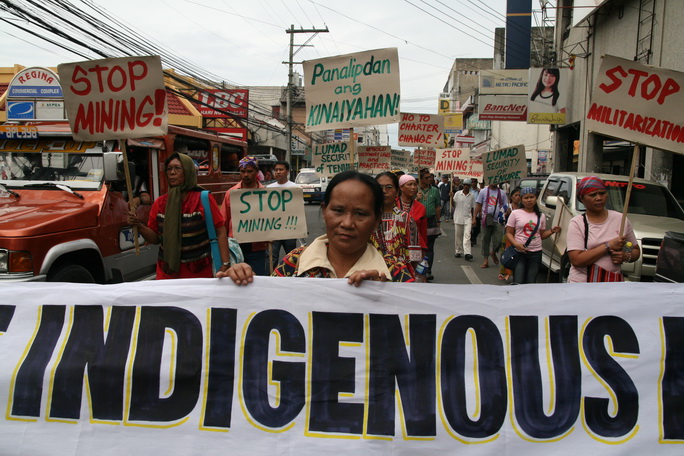
November 20, 2016; Indian Country Today
On a global scale, indigenous people too often face violence to hold on to their ancestral lands.
Laura Zúñiga Cáceres knows only too well the risks she faces in the struggle for land rights for her Lenca people in Honduras. Her mother, Berta Cáceres, was murdered in March, just a year after winning an international award for her efforts to block construction of a dam on the Gualcarque River.
International Funders for Indigenous People (IFIP), an umbrella organization of philanthropic groups, works to expand the work of activists who advocate for the rights of such communities.
This Indian Country Today article brings to our attention the growing challenges associated with indigenous philanthropy. The purpose of such philanthropy is to support activists who work to counter negative risks to vulnerable populations as emerging economies increasingly globalize. According to Astrid Puentes, co-executive director of the Interamerican Association for Environmental Defense (AIDA), Latin American societies are “the most unequal in the world, and indigenous peoples remain the most disenfranchised.”
Riding a boom in prices of commodities such as oil, minerals, and timber, Latin American countries grew wealthier over the past two decades. As countries such as Ecuador, Peru, and Brazil move into the middle-income bracket, many philanthropic organizations are reducing their funding for projects there.
Indigenous people are becoming more vulnerable as “increasingly, mining, oil drilling, hydroelectric dams, oil palm plantations and other large-scale projects are encroaching.” Indigenous activists need adequate support to help them lobby or confront the governments, corporations, and lenders behind these threatening industrial projects.
Sign up for our free newsletters
Subscribe to NPQ's newsletters to have our top stories delivered directly to your inbox.
By signing up, you agree to our privacy policy and terms of use, and to receive messages from NPQ and our partners.
To exacerbate existing funding challenges, activism is becoming increasingly riddled with danger. For their protection, activists need safety equipment, including security cameras, vehicles, and satellite phones “in places where there is no mobile phone service [or] electricity to charge devices.” The article further states that legal aid funding continues to dry up as lawyers are increasingly harassed for their much-needed litigation regarding the “defense of indigenous activists and defense of territorial rights.”
A core theme in the article is how high-profile philanthropic awards can backfire. It elaborates on the story of Berta Cáceras. Cáceras was a leading indigenous persons activist and founder of the Council of Popular and Indigenous Organizations of Honduras (COPINH). In 2015, she won the Goldman Environmental Prize for her dominant life-risking role in persuading the abandonment of the notorious Agua Zarca Dam project along Western Hondura’s Gualcarque River, a territory inhabited by the indigenous Lenca people. In March 2016, she was assassinated. She was gunned down at home, in a town called La Esperanza.
The death of Cáceras shocked many. Yet her daughter, Laura Zúñiga Cáceras, tells Indian Country Today that her mother’s struggles and death are known only too well to environmental activists who defend indigenous people. “Several colleagues have been murdered since then, and indigenous leaders throughout Latin America face threats in similar struggles.” According to IFIP, “40 percent of environmental activists assassinated from 2010 to 2015 were indigenous leaders.” The article states that Brazil had the greatest number of environmental activists murdered in 2015, citing a report by a nonprofit organization called Global Witness that found, “Honduras has the highest number of murders per capita.”
Fears are growing about the risks involved with protecting leading activists like Cáceras, as any “increased visibility could make them easier to target. The dangers worry both indigenous leaders, and people who support their causes.” This challenge perpetuates growing interests in strategizing “indigenous-led philanthropy.” Maria Amalia Souza, executive director of the Brazil-based Casa Socio-Environmental Fund, supports this prototype. She says it can be promoted through enhanced networking capabilities with local organizations that can expedite funding support streams. Such networking can also “build relationships of trust” while identifying “funding gaps.”
Myrna Cunningham, a Miskito woman who was former governor of Nicaragua’s North Atlantic Coastal region after serving in the country’s legislature and health ministry, encourages indigenous organizations to play larger roles in grant handling and funds appropriation. Jessica Brown, executive director of the New England Biolabs Foundation and IFIP board member, argues that funders must take caution to “ensure that their own investments do not harm the groups they seek to help.” Nashieeli Valencia Núñez, member of the Assembly of Indigenous Peoples of the Isthmus of Tehuantepec in Defense of Land and Territory, reminds philanthropists to bear in mind that “even green projects can harm indigenous communities,” which is why Brown notes that “many are divesting in fossil fuels.”
The article ends by encouraging respect for the decision-making powers of indigenous people. Indigenous-led philanthropy is meant to foster this way forward. As Valencia says, it is meant to encourage “governments to move towards an energy transition that is really just.” Souza explains, “the only people who can do the work are the people who are living in the fragile ecosystems.” Philanthropic organizations are increasingly challenged to rethink strategies. They need to realistically support the plights of indigenous communities even as security issues prove increasingly “urgent and complex.”—Noreen Ohlrich













